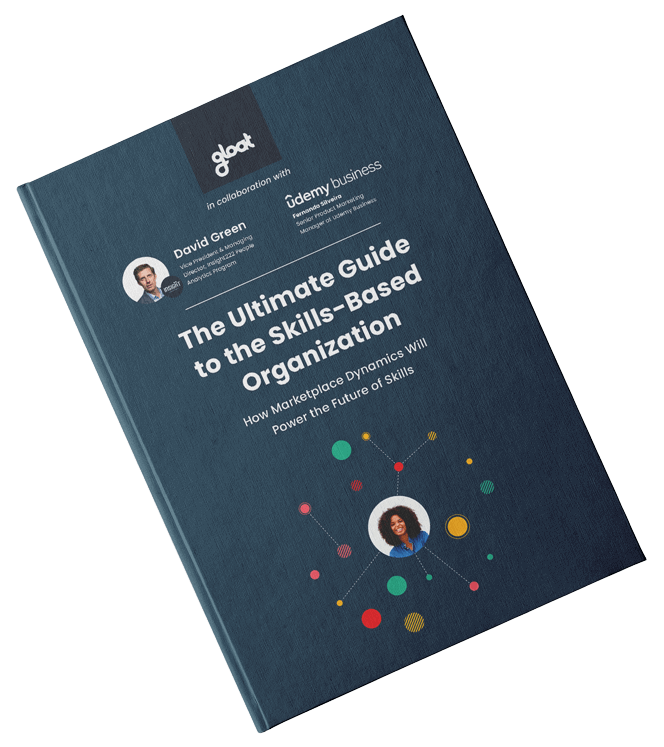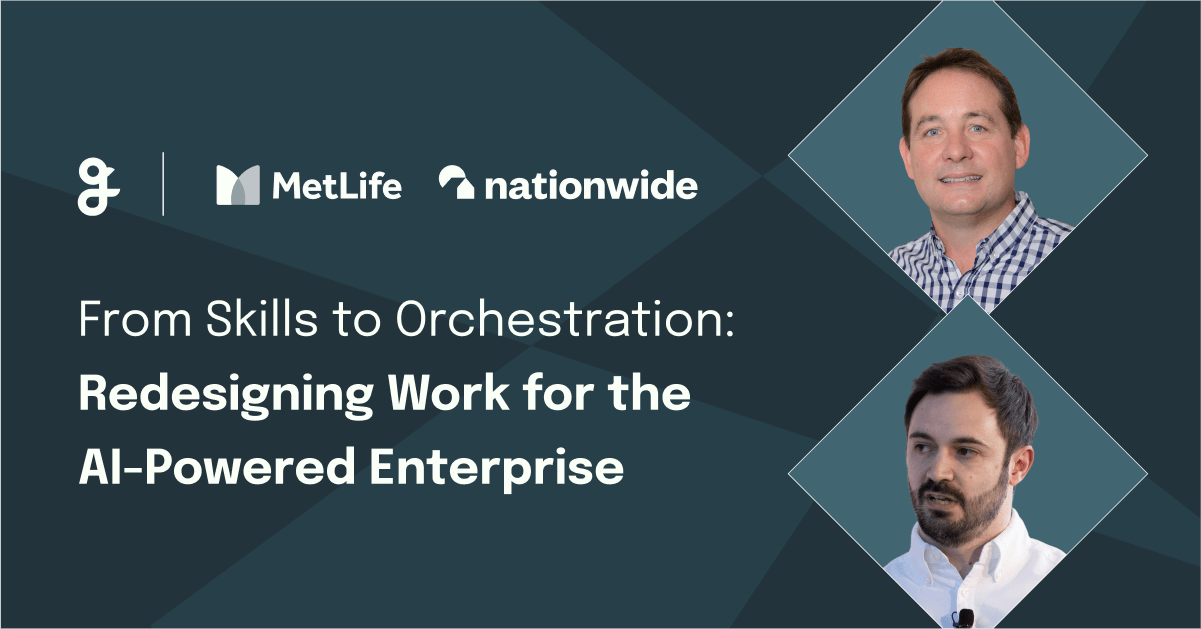What is a workforce skills plan and why is it important?
Stay one step ahead of fast-evolving, future-fit capabilities

There’s a lot of uncertainty in the new world of work—but one thing leaders can be sure of is that skill gaps will continue to pose a threat to their organization’s performance. 70% of executives already cite these shortages as a top external challenge and fear that workers aren’t reskilling fast enough to reap the benefits of new technologies.
A lack of in-demand expertise doesn’t just slow output levels; it has the potential to hurt an organization’s bottom line. In fact, recent research from McKinsey reveals that more than one in four leaders believe that failing to capture the needed skills could directly harm their financial performance and indirectly impede their efforts to leverage value from AI.
Fortunately, working with ever-widening skill gaps doesn’t have to become your business’s reality. Rather than thinking only about the capabilities your people currently need, visionary leaders are developing workforce skills plans that assess the knowledge their people have and the competencies they must develop to ensure their business stays successful in our fast-paced and ever-evolving world of work.
What is a workforce skills plan?
A workforce skills plan is a strategic investment in developing workforce capabilities. It showcases the skills your organization currently has and the competencies employees will need to build in order to deliver on strategic business priorities.
Workforce skills plans are designed to prevent any scenario in which your business embarks on an ambitious strategic objective only to discover that your workforce is missing some of the key competencies needed to execute on these deliverables. The best workforce skills plans are rooted in the needs of the business and aligned with executives’ long-term visions for how your organization must grow and evolve.
Why do organizations need a workforce skills plan?
In the old world of work when skill needs and processes were stable and predictable, workforce skills plans weren’t a priority. Employees generally performed the same sets of roles and responsibilities with little variance, so there was no need to plan what kind of capabilities people might need in the future.
However, now that we’re in the Post-Industrial era of work, that’s all about to change. People are using technological advancements to work more efficiently and innovate at rates we’ve never seen before. With this accelerated pace of change comes new and pressing needs to identify the skills your organization will need to be successful not only now but in the future—which is where a workforce skills plan comes into play. It can map not only the capabilities your people currently have but also the complementary and transferable skills they will need to build to give your business a competitive advantage in the future.
While keeping track of skills was once a tedious manual exercise, HR leaders can now turn to a new generation of AI-powered skills intelligence tools to gain a complete understanding of their workforce’s skills as they evolve in real-time, creating the perfect foundation for a comprehensive workforce skills plan.
Key components of a workforce skills plan
There are several different elements that go into a successful workforce skills plan, including:
#1. Skill gap analysis
Before leaders can bridge skill gaps, they must take stock of the capabilities their people have as well as existing knowledge shortages. To see where their workforce skills might be falling short, leaders can conduct a skill gap analysis, which identifies which learning and development initiatives should be prioritized. Once HR is aware of any knowledge gaps, they can start to create strategies to overcome existing shortages—including hiring externally for new skills or redeploying or reskilling internal talent.
#2. Skills benchmarking
As leaders begin crafting their workforce skills plan, it can be helpful to get an idea of how their workforce’s capabilities compare with organizational and industry-wide standards, which is exactly what skills benchmarking provides. Leaders can measure employees’ skills and skill levels to determine whether an individual has the required skill sets and proficiencies to perform a role and identify upskilling opportunities to bridge knowledge gaps.
Skills intelligence tools make this level of comparison and analysis possible. Without these AI-powered systems, it’s next to impossible to explore how one workforce’s competencies compare to another’s. As skills intelligence tools go mainstream, more organizations can evaluate their workforce’s capabilities against their competitors and adjust their workforce skills plans accordingly.
#3. Development plans
Once leaders have an in-depth understanding of their workforce’s skills and any emerging knowledge gaps, they must architect a plan to help employees build the competencies outlined in their workforce skills plan. Employees need multiple pathways to hone new skills, including having the opportunity to pitch in on projects and gigs so they can build on the job experience.
A talent marketplace that matches people to open opportunities based on the experiences they have and the skills they wish to build can be a game-changer for employee development. The platforms can also help employees find mentors in their organizations so they can receive one-on-one guidance as they strive to expand their skill sets.
#4. Evaluation and monitoring
A workforce skills plan isn’t complete once leaders have drafted it. Instead, executives must carefully monitor their organization’s skill-building efforts to determine who is participating in development opportunities and how these opportunities are bringing employees closer to completing overarching skill goals.
Leaders must also continue to check in with skills intelligence tools so they can get an idea of which capabilities are growing more important and which are declining based on market and industry trends. Based on this information, leaders may choose to deprioritize developing a certain competency so they can shift gears and focus on skills that are more in-demand.
Benefits of a workforce skills plan
Businesses that create and utilize a workforce skills plan enjoy several enterprise-wide benefits, such as:
#1. Identify skill gaps
All too often, leaders don’t realize they have a skills shortage problem until it’s too late. Skill gaps slow productivity and diminish performance because employees have to develop workarounds or reach out to colleagues in order to compensate for whatever skill they are missing. Rather than letting output levels suffer, organizations that have a workforce skills plan can proactively develop new competencies to ensure a lack of expertise never slows their business down.
#2. Encourage employees to build new skills
Workforce skills plans send a clear signal to your entire organization that leaders view continuous learning and development as an utmost priority. When all employees are aligned on the skills their organizations need to be successful—both now and in the future—they will be inspired to continue skill-building activities so they can play their part in helping the business reach its overarching goals. A workforce skills plan creates a sense of transparency and reminds employees that they all must come together for this common goal.
#3. Save on external hiring
When organizations encounter skill gaps, they have a few choices: they can develop talent internally, they can borrow it from another team, or they can buy it by hiring externally. While the last option has traditionally been the most common solution, it’s also the most expensive. Bringing new talent into an organization can come with high price tags, with the average cost per external hire estimated to be $4,683 or $28,329 for an executive position—and that’s before all of the costs associated with training and onboarding are taken into account.
Rather than footing the bill for new talent in an ultra-competitive labor market, savvy business leaders are prioritizing internal mobility. To develop the internal talent they’ll need, leaders must have a workforce skills plan that maps out exactly what capabilities they’re looking for.
#4. Cultivate a culture of learning
A workforce skills plan can pave the way for cultivating a culture that prioritizes learning and development. When leaders and managers have an idea of the skills their workforce will need to build in the future, they can come up with creative and engaging tactics for developing these competencies—such as mentoring initiatives and projects and gigs for experiential learning. Instead of viewing training as a chore or something to check off to-do lists, workforce skills plans turn these development initiatives into opportunities to come together to support the future of the organization.
If you’re looking to learn more about what a successful workforce skills plan looks like in action, check out our ultimate guide to the skills-based organization to see the schemes leading companies like Schneider Electric and HSBC created.





